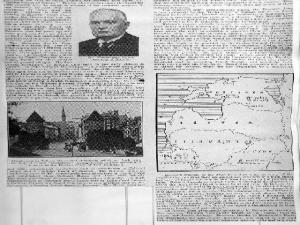Inglise ajalehtedest
4. 1. 38 News Chronicle
ESTONIA MOVES TOWARDS
DEMOCRACY
An event of far reaching consequence occurred this week in one of the Baltic States: Estonia emerged from the purgatory of Dictatorship.
She has broken away from the group of “authoritarian” States separating Russia and Germany and moved towards the circle of world democracies which she abandoned in 1934. The new Constitution of the Estonian Republic has come into force.
Estonia, like all the other young States born of the World War, and of the principle of self-determination, has suffered from the usual ailments of political children.
*
The germs of her disease were economic. An internal crisis in 1933, exploited by an association of discontented ex-Servicemen, led to the abolition by plebicite of the democratic Constitution promulgated thirteen years earlier and to the establishment of a Fascist Government.
An overwhelming majority of voters welcomed the suppression of what was called “the dictatorship of Parliament” and its replacement by the dictatorship of the Chief of State.
Estonia had her “Fuehrer.” Fortunately for Estonia her Chief of State was and is, in his heart, a democrat: Konstantin Päts – President and Prime Minister in one.
He was too familiar with both Russian and German concentration camps during the occupation of Estonia by the troops of these two countries to harbour anything but unfriendly feelings towards the use of force.
After 13 years of difficult navigation President Päts has at last succeeded by means of those dictatorial powers with which he had been invested, in steering his country onto the calm waters of democratic government.
In this task two men stood at his side: the Commander-in-Chief of the Armed Forces, General J. Laidoner, deliverer of Estonia from her Russian and Prussian invaders after the World War, and the Minister for Economic Affairs, Karl Selter, to whose foresight the country owes in great measure its economic rehabilitaion.
*
The new Estonian Constitution embodies not only some of the principles of democratic popular government that imbued the Constitution of the year 1920, but contains also the lessons learnt by the frustrated application of the old Constitution.
The powers of the President are admittedly far-reaching. Though he must obtain for his decisions the counter-signature of a Government possessing the confidence of the Parliament, he can suspend by veto the promulgation of legislation enacted by Parliament.
He can even make laws in the form of decrees. But his right to issue decrees is limited. The Budget, the ratification of treaties and the laws of concerning the structure of State power are outside the President’s reach.
The fundamental right of Parliament to superintend the State treasury is assured in full.
*
After having been tossed about by domestic troubles and party factions ever since her birth as a nation, and situated as she is between her former masters – Fascism in the West and Communism in the East – the Estonian Republic cannot afford a Constitution that corresponds theoretically to all ideals of humanity but falls practically in times of emergency.
The new Constitution makes sure that the Government is provided with all the means necessary for the defence of peace at home and abroad.
The present economic position of Estonia is another pledge for the smooth working of the new Constitution. In 1937 the total production of goods reached a record figure. Though primarily an agricultural country, Estonia has recently experienced a rapid industrial development, mainly through the exploitation of her national resources.
During recent years the Budget has been balanced, and since 1931 the trade turnover of Estonia has more than doubled. Trade with the United Kingdom has shown conciderable improvement.
*
The value of imports from Estonia to this country in the first nine months of 1937 was
L 1,620,838. Exports amounted to L 1,073,338. The corresponding figures 1936 were L 1,550,540 and L 516,788, and for 1935 L 1,444,495 and L 481,135.
At a time when the Fascist germ has just added Rumania to the number of nations on the sick list, the new Estonian Constitution is not only a gain for democracy in general.
It means that Estonia is moving gradually into line with Finland, to whom it is already attached by ties of blood, and with the Scandinavian bloc.
The importance of this tendency in the field of foreign policy is evident: if today a roll call of democratic States were taken by Great Britain, America and France, Estonia would be able to step forward and say: “Here.”
The other Baltic States, Latvia and Lithuania, have not yet reached that stage. Poland, too, still lags behind. But the fresh air of demographic government will now filter into that part of the world through the “Window on the Baltic,” as Peter the Great called Reval, now Tallinn, the capital of Estonia.
The new Constitution may therefore mean a turning point, not only in Estonian, but also in Baltic history.
In no country is history so unpopular as in Estonia – and no wonder: it is a history of invasion, bondage and servitude. For five centuries Estonia has been the battleground of two worlds, the East and the West.
First the West won, then the East; but in the end liberty won.
*
Estonia is a young Republic. It is not yet of age. On February 24 it will celebrate its 20th birthday.
In the course of centuries the citadel of Tallinn has seen many colours hoisted on its spire. Now the blue, black and white flag of the Sovereign and Independent Estonian Republic proclaims in the words of the new Constitution: “The territory of the Estonian State is one and indivisible.”
Advertisement / Reklaam
Advertisement / Reklaam
Lionel Smith
























